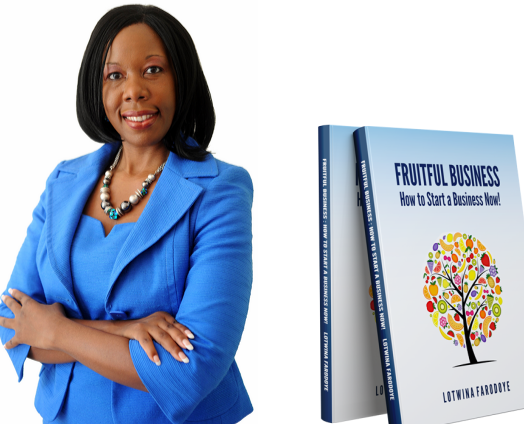Four years ago I wrote and published my first non-fiction book on Career Change (recently rewritten and updated). I learned so much during the process that I started this site and since then it has been my mission to help people release the book inside.
 I am especially proud when people I teach publish their words into the world. A year ago, successful business-woman Lotwina Farodoye attended one of my full day events in London and now she has her own book, Fruitful Business, out there. Today she shares what she has learned on the journey.
I am especially proud when people I teach publish their words into the world. A year ago, successful business-woman Lotwina Farodoye attended one of my full day events in London and now she has her own book, Fruitful Business, out there. Today she shares what she has learned on the journey.
You?ve probably heard the phrase ?there is a book inside all of us?.? For me this was true, but rather than ?whether? to write, my dilemma consisted of ?what to write? and ?how to get started? because I had several ideas and concepts inside of me bursting to get out. I knew I would need to narrow it down if I was to ever reach my goal of becoming a published author.
Attending Joanna?s non-fiction book writing workshop helped me to clarify my thoughts and fashion out a successful path to publishing my book. Here are the steps I found most useful.
1) Decide what you will write
Go with what you know most about and are most passionate about.? This way you will be both engaging and authentic. As a non-fiction author, people? expect? truth, either from your experience or knowledge so you need to write with authority on your subject matter
Your non-fiction book can help to position you as an expert in your field, open doors in your career including speaking engagements, as well as gain you more clients, so choose a topic that you want to be associated with now and in the future, rather than a past endeavor that is no longer current.
Write what?s relevant to your target readership. You can do this in many ways for example by addressing a problem or need, clearing up an area of ambiguity, presenting new information, or presenting existing information in a fresh way by applying it to different contexts.
When I wrote my book, I decided to base it on the topic I?m most passionate about and have significant experience on, which is How to Start a Business.? I knew my content would be relevant to my target readership because I used each chapter to address the questions I get asked most frequently, especially when I?m speaking at conferences, which is a strong indication of what my target audience would like to know.
2) Make a chapter plan
Flesh out a plan for each chapter at the beginning of the writing project. Your chapter plan should include the topics you are going to cover within in each chapter and as well as the subtopics, and any examples you plan to use to support your concepts, theories and ideas.
A chapter plan can take many forms, while some prefer flow charts or lists, others prefer spider diagrams or mind maps. As long as you can read and understand your plan for each chapter then it?s right for you.
My chapter plans were in the form of mind maps. Each chapter plan looked like a spider?s web with the central theme in the middle, and strands radiating from the middle on which I wrote my subheadings, with further strands as examples. I found that the hours I spent up front producing my chapter plans paid off as once I started writing, I could keep going until all of the concepts and ideas I?d brainstormed at the beginning of my project were exhausted.
Your plan enables you to know where you?re heading with your book so that you write in a focused manner and don?t go off on a tangent.? Also, by making a plan at the beginning of your project, you are less likely to dry up or run out of words as you progress.
When you?ve finished writing about the topics in the first section of the plan, you simply tick the off and move on to writing the next topic that you?ve earmarked.? This is particularly useful if you?ve taken a break in your writing for any length of time, you always now where you left off and can resume quickly.
3) Make a time plan, the shorter the better
With many fiction authors spending years penning their books, non-fiction deadlines need to be shorter simply because we are living in a digital age with knowledge advancing at breakneck speed. Taking years to write a non-fiction book could render it?s concepts out of date pretty quickly.? As a general rule of thumb, aim for three to six months to complete your first full draft and aim to publish within the year. You can always release a new, updated version later.
4) Buddy Up!
Writing a book can be a lonely business. It can be a great help to have a like-minded person to be accountable to. This could be anyone, but preferably someone who is also undertaking or has undertaken a writing project as they will be able to empathize with you and find mutual encouragement.
Being able to pick up the phone for a chat, or meeting up for a coffee can go a long way to lightening the writing process. Discussing your writing targets with your buddy will keep them at the forefront of your mind and spur you on. You can find writing ?buddies? through joining your local writers circle, or joining a writers ?meet up?, or on a course, or even persuade a friend to start a writing project.
Knowing that I had buddies that would ring me to ask me my progress on the book front helped keep me on track.? When I made progress it was great to have buddies to celebrate with knowing I was spurring them on too.? I found my buddies on the writing course I attended and still enjoy keeping in touch even though I?ve now completed my book.
5)? Don?t look back
Once you have your chapter plans in place, start writing and keep going forward.? Don?t look back to re-read what you?ve written or you might keep tweaking it and risk getting stuck in ?tweaking mode? .? Instead, finish writing out all that you have in your plans so that you complete the first draft of your manuscript.? Once you have your manuscript, you can re-read it in order to tweak, improve, re-phrase and tighten up in places.
Once you?ve improved your manuscript as best you can you are ready to send it to ?beta readers?. Beta readers are people in your target audience that will give you their honest opinion on your work. Be open minded about the comments you receive back and use them to polish your draft to the best it can be getting it to final status, ready for a professional editor.
I sent my manuscript to five beta readers. I gave them a timescale of 2 weeks to feedback so as not to unduly lengthen my project, and thank fully all obliged.? All of my beta readers provided invaluable feedback albeit in different forms.
6) Use a professional editor
I found my editor through Joanna?s list of recommended editors and I chose Liz Broomfield, Libroediting because she was recommended, reasonably priced and as an author of non-fiction, understood the genre well. I was very happy with Liz?s input and would use her again.
[Find out more on the editing and rewriting process here]
7) Include references back to your website
Within your book, make sure you ask readers to refer back to your website for information that you would like to include in your book but are conscious may be subject to change or date quickly, e.g. references to legislation or professional associations. That way you can update the information on the website rather than having to re-submit files of your book.
Directing people back to your website also means that people will be more likely to sign up for your newsletter and you?ll be able to communicate with them directly over time. For non-fiction writers, this is important as extra revenue will come from speaking engagements or sale of other products/services.
8) Produce both paperback and ebook
Where my non-fiction book is concerned, I?ve sold more paperbacks than ebooks which is common if you have a speaking platform or a physical community of people to market to.
Paperbacks are easy to produce via print on demand services. I used Amazon?s Createspace for my paperback and Amazon KDP for my Kindle version. Both platforms were easy to understand and use. [See How to Publish A Book 101 for more details]
9) Get a great looking cover that is suitable for your genre
Non-fiction books tend to have simpler cleaner looking covers versus fiction, some simply with text.
Browse the bestselling books in your genre to understand what works well then work with a professional designer to ensure your book stands out in a crowded market.
10) Celebrate your success, but don?t put your feet up for too long!
There?s marketing to be done and for that I recommend you check out Joanna?s book marketing resources!
 Lotwina Farodoye is an award-winning businesswoman, sought-after public speaker and business consultant. After being made redundant in 2008, Lotwina started her own business and soon her natural fruit bars were in national supermarkets and available globally online. She successfully sold the business 3 years later.
Lotwina Farodoye is an award-winning businesswoman, sought-after public speaker and business consultant. After being made redundant in 2008, Lotwina started her own business and soon her natural fruit bars were in national supermarkets and available globally online. She successfully sold the business 3 years later.
Lotwina is the author of ?Fruitful Business: How to Start a Business Now!? where she shares her tips and strategies for successful business. The book is available now on in paperback and Kindle formats.?
Top Image: BigStockPhoto Red Cherries in a bowl
Source: http://www.thecreativepenn.com/2013/02/20/write-publish-non-fiction/
the last waltz earth day activities mel gibson splunk dark shadows iau msft
No comments:
Post a Comment
Note: Only a member of this blog may post a comment.